AUDI S6 2016 Owners Manual
Manufacturer: AUDI, Model Year: 2016, Model line: S6, Model: AUDI S6 2016Pages: 294, PDF Size: 73.88 MB
Page 131 of 294
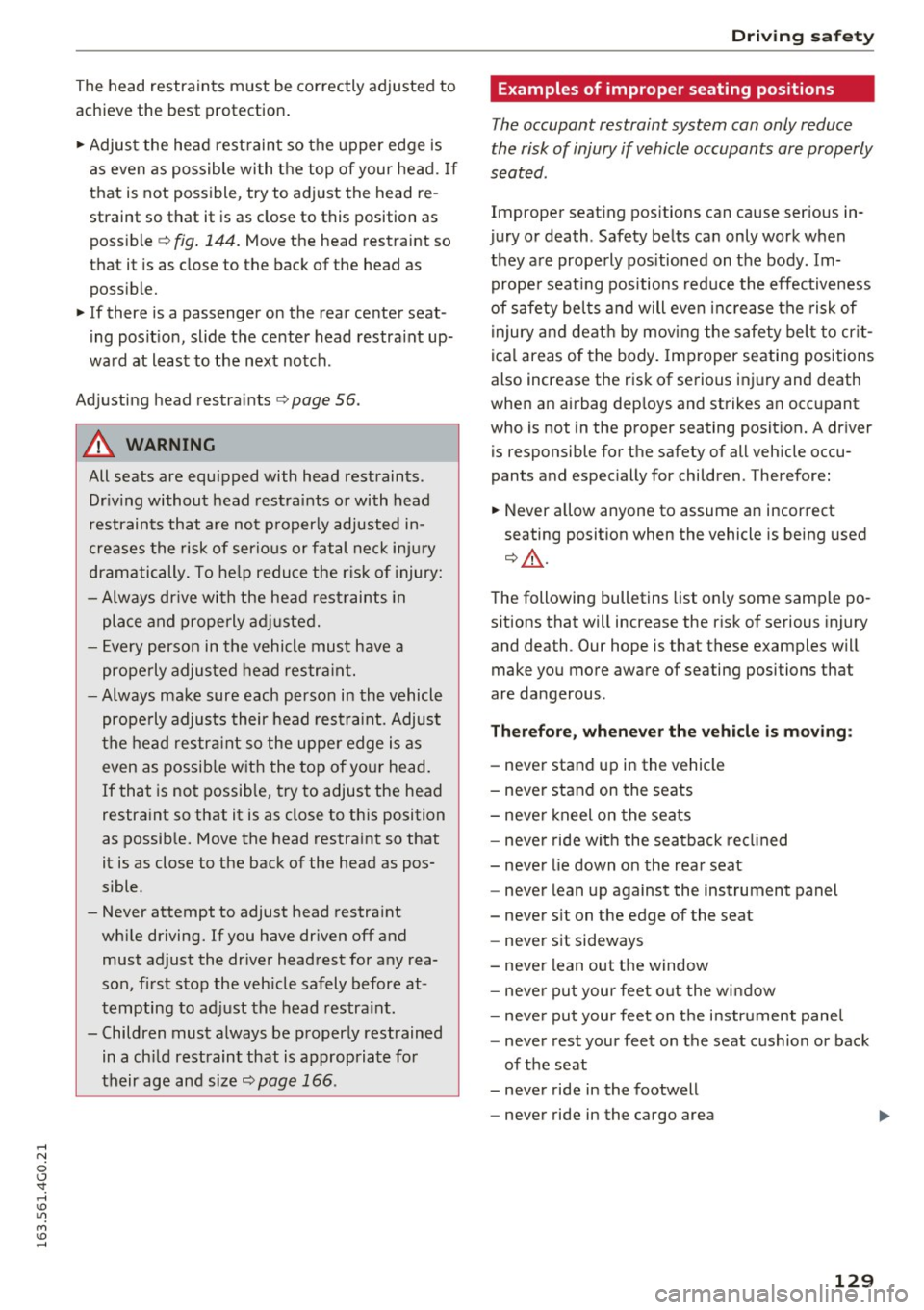
The head restraints must be correctly adjusted to
achieve the best protection. .,. Adjust the head restraint so the upper edge is
as even as possible with the top of your head. If
that is not possible, try to adjust the head re
straint so that it is as close to this position as
poss ible ¢
fig. 144. Move the head restraint so
that it is as close to the back of the head as
possible.
... If there is a passenger on the rear center seat
ing posit ion, slide the center head restraint up
ward at least to the next notch.
Adjusting head restraints
c> page 56.
_& WARNING
All seats are equipped with head restraints .
Dr iving without head restraints or with head
restraints that are not properly adjusted in
creases the risk of serious or fatal neck injury
dramatically. To help reduce the risk of injury:
- Always dr ive with the head restraints in
place and properly adjusted.
- Every person in the vehicle must have a
properly adjusted head restra int.
- Always make sure each person in the vehicle
properly adjusts their head restraint. Adjust
the head restra int so the upper edge is as
even as possible with the top of your head.
If that is not possible, try to adjust the head
restraint so that it is as close to this position
as possib le. Move the head restraint so that
it is as close to the back of the head as pos
sible.
- Never attempt to adjust head restraint
while driving. If you have driven off and
must adjust the driver headrest for any rea
son, first stop the vehicle safely before at
tempting to adjust the head restra int.
- Children must always be properly restrained in a ch ild restraint that is appropriate for
their age and size
c> page 166 .
-
Driving safety
Examples of improper seating positions
The occupant restraint system can only reduce
the risk of injury if vehicle occupants are properly
seated.
Improper seating positions can cause serious in
jury or death . Safety belts can only work when
they are properly positioned on the body . Im
proper seat ing positions reduce the effectiveness
of safety belts and will even increase the risk of
injury and death by moving the safety belt to crit
ical areas of the body. Improper seating positions
also increase the risk of serious injury and death
when an airbag deploys and strikes an occupant
who is not in the proper seating position. A driver
is responsible for the safety of all vehicle occu
pants and especially for children . Therefore:
... Never allow anyone to assume an incorrect
seating position when the vehicle is being used
c> .,& .
The following bulletins list only some sample po
sitions that will increase the risk of serious injury
and death . Our hope is that these examples will
make you more aware of seating positions that
are dangerous .
Therefore, whenever the vehicle is moving:
-never stand up in the vehicle
- never stand on the seats
- never kneel on the seats
- never ride with the seatback recl ined
- never lie down on the rear seat
- never lean up against the instrument panel
- never sit on the edge of the seat
- never sit sideways
- never lean out the window
- never put your feet out the window
- never put your feet on the instrument panel
- never rest your feet on the seat cushion or back
of the seat
- never ride in the footwell
- never ride in the cargo area
129
Page 132 of 294
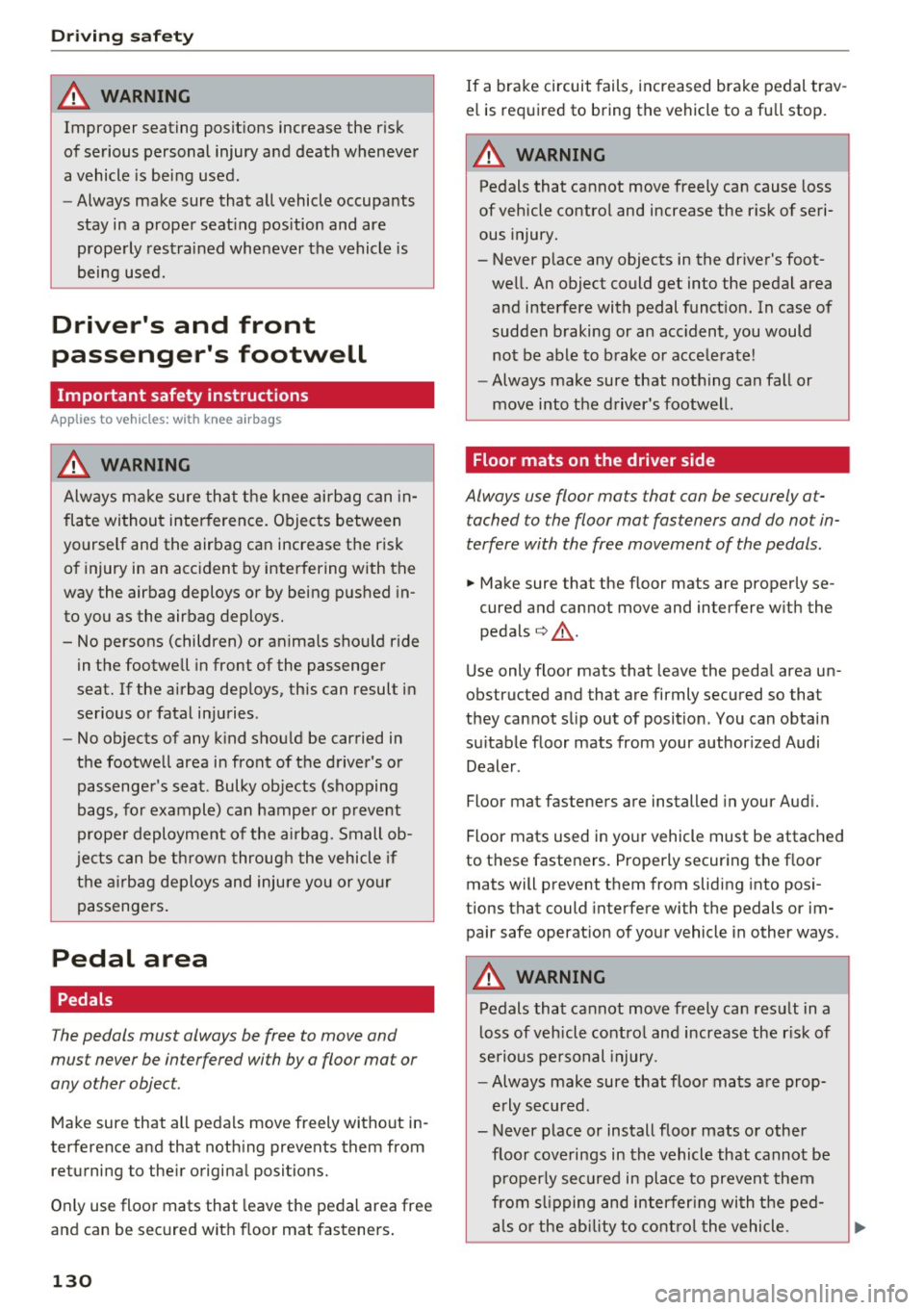
Driving sa fe ty
A WARNING
Improper seating positions increase the r isk
of serious personal injury and death whenever
a vehicle is being used.
- Always make sure that all vehicle occupants
stay in a proper seat ing position and are
properly restrained whenever the vehicle is
being used.
Driver's and front
passenger's footwell
Important safety instructions
A ppl ies to veh icles : w ith knee a ir b ags
A WARNING
Alw ays ma ke sure that the knee airbag can in
flate without inter ference. Objects between
yourself and the airbag can increase the risk of injury in an acc ident by interfering with the
way the airbag deploys or by being pushed in
to you as the airbag deploys.
- No persons (children) or animals shou ld ride
in the footwell in front of the passenger
seat. If the airbag dep loys, th is can result in
serious or fatal in ju ries .
- No objects of any k ind shou ld be carried in
the footwell area in front of the driver 's or
passenger's seat. Bulky objects (shopping
bags, for example) can hamper or p revent
prope r deployment of the airbag. Small ob
jects can be th rown throug h the vehicle if
the airb ag deploys and injure you or your
passengers.
Pedal area
Pedals
The pedals must always be free to move and
must never be interfered with by a floor mat or
any other object.
Make sure that all pedals move freely without in
terference and that noth ing prevents them from
returning to the ir origina l positions.
O nly use floor mats that leave the pedal area free
and can be secured wit h floor mat fasteners .
130
If a brake circuit fails, increased brake pedal trav
el is required to bring the vehicle to a fu ll stop.
A WARNING
Pedals that cannot move freely can cause loss
of vehicle contro l and increase the r isk of seri
ous injury.
- Never p lace any objects in the drive r's foot
well. An object could get into the pedal area
and interfere with pedal funct ion. In case of
sudden braking or an acc ident, you would
no t be able to b rake o r acce le rate!
- Always make sure that nothing can fall or
move into the driver's footwell.
Floor mats on the driver side
Always use floor mats that can be securely at tached to the floor mat fasteners and do not in
terfere with the free movement of the pedals .
.,. Make sure that the floor mats are properly se
cured and cannot move and interfere w ith the
pedals¢ .&,.
Use only floor mats that leave the peda l area un
obstructed and that are firmly secured so that
they can not s lip out of position . You can obtai n
su itable floor mats from your author ized Audi
Dealer .
Floor mat fasteners are installed in your Aud i.
Floor mats used in yo ur vehicle must be attached
to these fasteners. Properly secur ing the floor
mats will prevent them from sliding into posi
tions that could inte rfere with the pedals or im
pair safe operat ion of your vehicle in other ways.
A WARNING
Pedals that ca nnot move freely can result in a
loss of vehicle contro l and increase the r is k of
serious pe rsonal injury.
- Always make sure that floo r mats are prop
erly secured.
- Never place or install floor mats or other floor coverings in the vehicle that cannot be
properly secured in place to preven t them
from s lipping and interfer ing wi th the ped
als or the ab ility to cont rol the vehicle.
Page 133 of 294
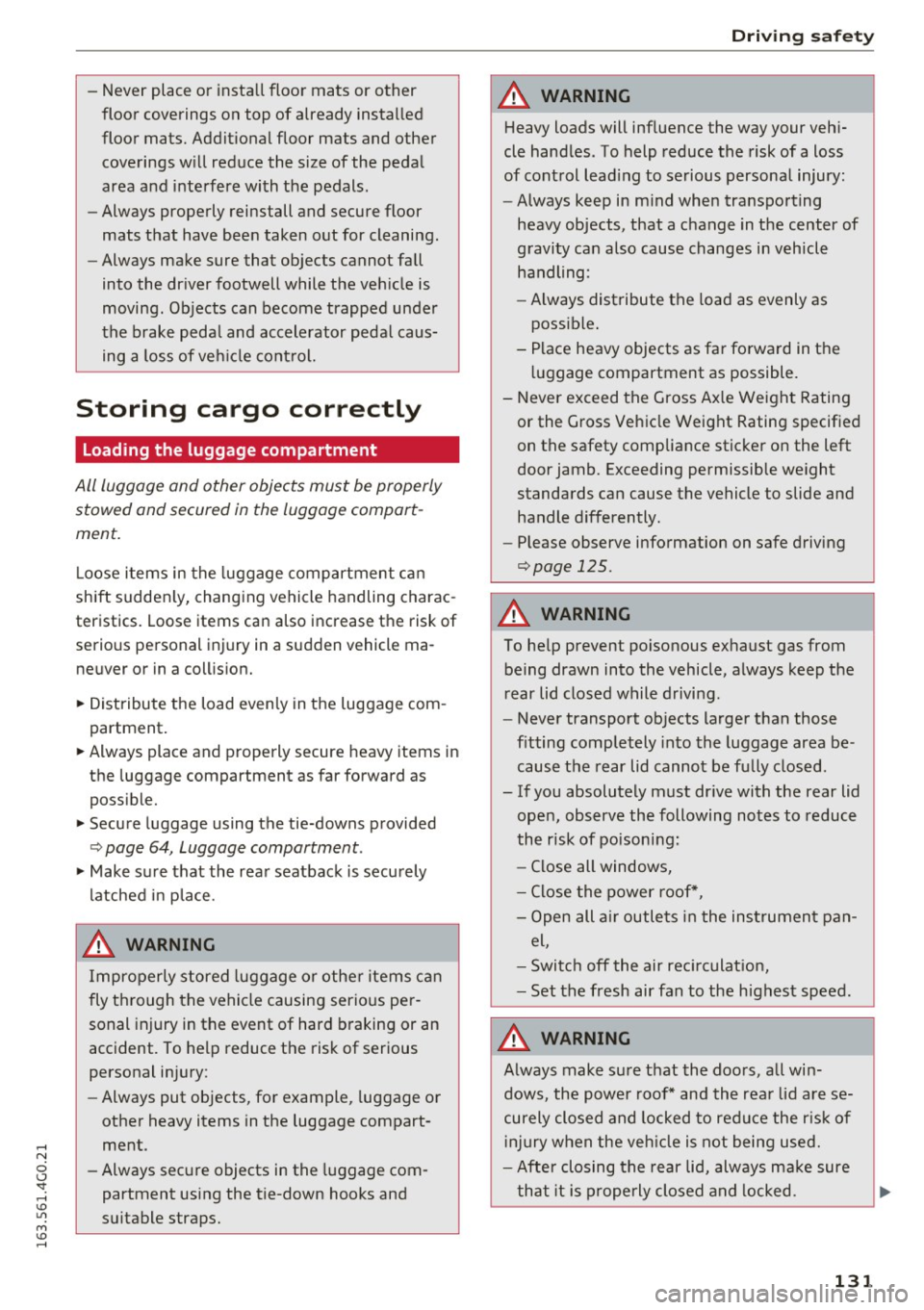
-Never place or install floor mats or other
floor coverings on top of already installed
floor mats. Additional floor mats and other
coverings will reduce the size of the pedal
area and interfere with the pedals .
- Always properly reinstall and secure floor
mats that have been taken out for cleaning.
- Always make sure that objects cannot fall
into the driver footwell while the vehicle is
moving . Objects can become trapped under
the brake pedal and accelerator pedal caus ing a loss of veh icle control.
Storing cargo correctly
Loading the luggage compartment
All luggage and other objects must be properly
stowed and secured in the luggage compart
ment.
L oose items in the luggage compartment can
shift suddenly, changing vehicle handling charac
teristics. Loose items can also increase the risk of
serious personal injury in a sudden vehicle ma
neuver or in a collision.
.. Distribute the load evenly in the luggage com
partment.
.. Always place and properly secure heavy items in
the luggage compartment as far forward as
possible.
.,. Secure luggage using the tie-downs provided
¢ page 64, Luggage compartment .
.,. Make sure that the rear seatback is securely
latched in place.
A WARNING
Improperly stored luggage or other items can
fly through the vehicle causing serious per
sonal injury in the event of hard braking or an
accident. To help reduce the risk of serious
personal injury:
- Always put objects, for example, luggage or
other heavy items in the luggage compart
ment.
- Always secure objects in the luggage com
partment using the tie-down hooks and
suitable straps.
Driving safety
A WARNING
Heavy loads will influence the way your vehi
cle handles. To help reduce the risk of a loss
of control lead ing to serious personal injury:
- Always keep in mind when transporting
heavy objects, that a change in the center of
gravity can also cause changes in vehicle handling:
- Always distribute the load as evenly as
possible .
- Place heavy objects as far forward in the
luggage compartment as possible.
- Never exceed the Gross Axle Weight Rating
or the Gross Vehicle Weight Rating specified
on the safety compliance sticker on the left
door jamb. Exceeding permissible weight
standards can cause the vehicle to slide and handle differently.
- Please observe information on safe driving
¢page 125.
A WARNING
To help prevent poisonous exhaust gas from
being drawn into the vehicle, always keep the
rear lid closed while driving .
- Never transport objects larger than those
f itting completely into the luggage area be
cause the rear lid cannot be fully closed.
- If you absolutely must drive with the rear lid open, observe the following notes to reduce
the risk of poisoning:
- Close all windows,
- Close the power roof*,
- Open all air outlets in the instrument pan-
el,
- Switch off the air recirculation,
- Set the fresh air fan to the highest speed .
A WARNING
Always make sure that the doors, all win
dows , the power roof* and the rear lid are se
curely closed and locked to reduce the r isk of
in jury when the vehicle is not being used.
- After closing the rear lid, always make sure
-
that it is properly closed and locked. ~
131
Page 134 of 294
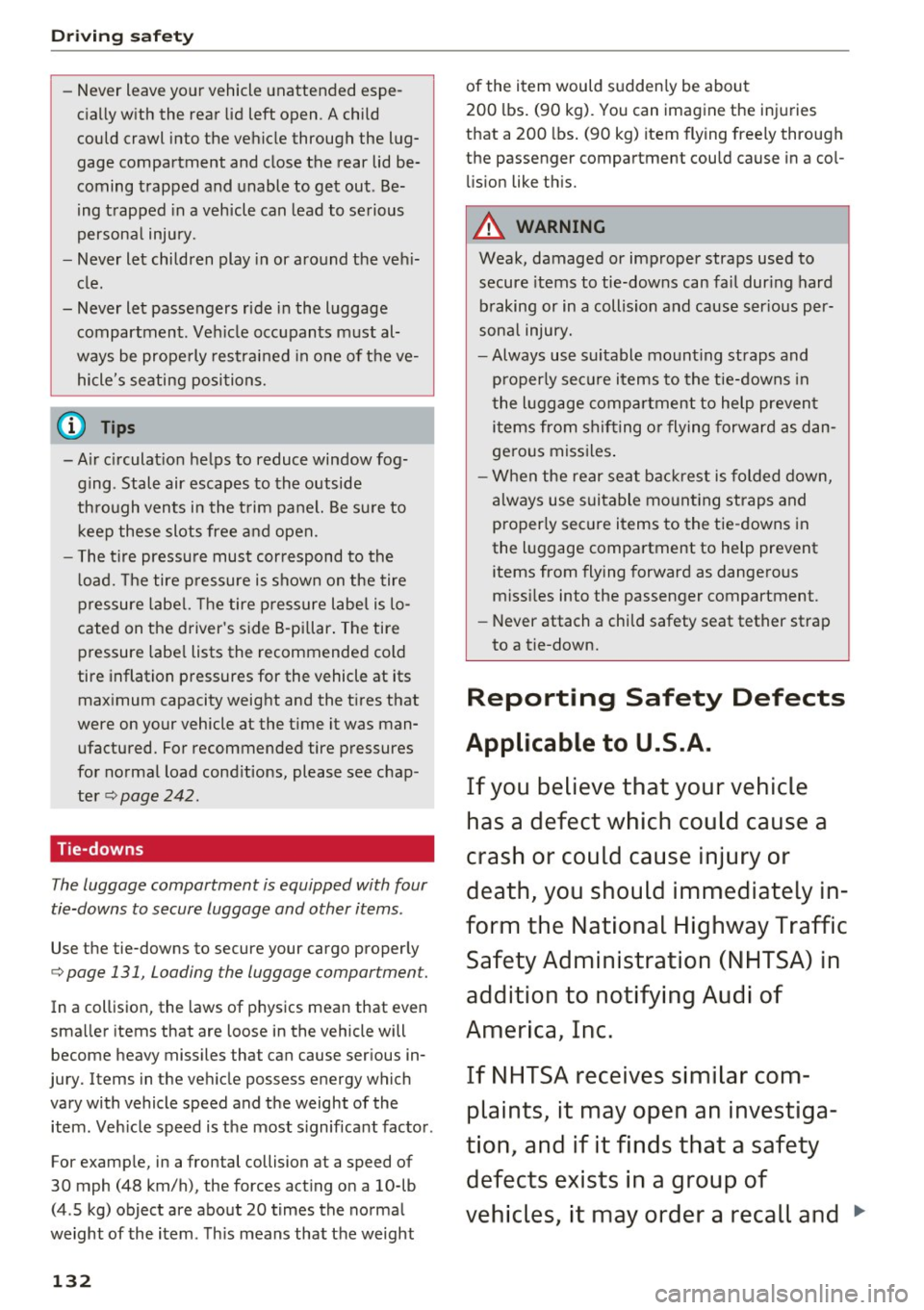
Driving sa fe ty
-Never lea ve yo ur vehicle unattended espe
c ially w ith the rear lid left open. A child
could crawl into the vehicle through the lug
gage compartment and close the rear lid be
coming trapped and unable to get out . Be
ing t rapped in a vehicle can lead to se rious
persona l injury.
- Never let children play in or aro und the veh i
cle.
- Never let passe ngers ride i n the luggage
compartmen t. Veh icle occupants m ust al
ways be prope rly restrained in one of t he ve
hicle's seating posi tions.
- A ir c irculat ion hel ps to reduce window fog
ging . Stale air escapes to the outside
th ro ugh vents i n the t rim panel. Be su re to
k eep these sl ots free and open.
- T he t ire pressu re mus t cor respond to the
l oad. The tire p ressure is shown on the tire
pressure l abe l. T he tire p ressure label is lo
cated on the driver 's s ide B-pi llar . The tire
pressure labe l lists the recommended cold
tire inflation p ressures for the vehicle at its
maximum capacity weight and the t ires that
were on your vehicle at the t ime it was man
ufactured. For recommended tire pressures
for normal load cond itions, please see chap
ter ¢
page 242 .
Tie-downs
The luggage compartment is equipped with four
tie-downs to secure luggage and other items .
Use the tie-downs to secure your cargo properly
¢ page 131, Loading the luggage compartment .
In a collision, the laws of p hysics mean that even
sma ller items that are loose in the vehicle will
become heavy missiles that can cause ser ious in
jury . Items in t he ve hicle possess energy wh ich
vary with vehicle speed and t he weight of the
item . Veh icle speed is the most s ignifica nt facto r.
For examp le, in a frontal collision at a speed of
30 mph (48 km/h) , the forces act ing o n a 10-lb
(4 . 5 kg) object are abo ut 20 times the normal
weight of the item . T his means that the weight
132
of the item would s udden ly be about
200 lbs . (90 kg) . You can imagine the inj uries
that a 200 lbs . (90 kg) item flying freely through
the passenger compartment could cause in a col
li sion like th is.
A WARNING
Weak, damaged or improper straps used to
secure items to tie-downs can fail dur ing hard
b raking or in a collision and cause ser ious per
sonal injury.
- Always use suitable mo unt ing straps and
pro perl y secure i tems to the tie-downs in
t he l uggage comp artmen t to help preven t
items from shi fting o r flying forwa rd as dan
ge rous miss iles .
- W hen the rear sea t bac krest is folded down,
a lways use suitable mo unti ng straps and
pro per ly secure items to the tie -downs in
the l uggage compa rtment to help prevent
items from flying forward as dangerous
m iss iles into the passenger compartment.
- Never attach a child safety seat tether strap
to a tie-down.
-
Reporting Safety Defects
Applicable to U.S.A.
If you belie ve that your vehicle
has a defect which could cause a
crash or could cause injury or
death, you should immedi ately in
form the National Highway Traffic Safet y Administration (NHTSA) in
a ddition to notifyin g Audi of
Ame rica, Inc.
If NHTSA re ceives s imilar com
plaints, it m ay open an in vestiga
tion , and if it finds that a safety
defe cts exist s in a group of
v e hicles, it m ay order a re call and ..,.
Page 135 of 294
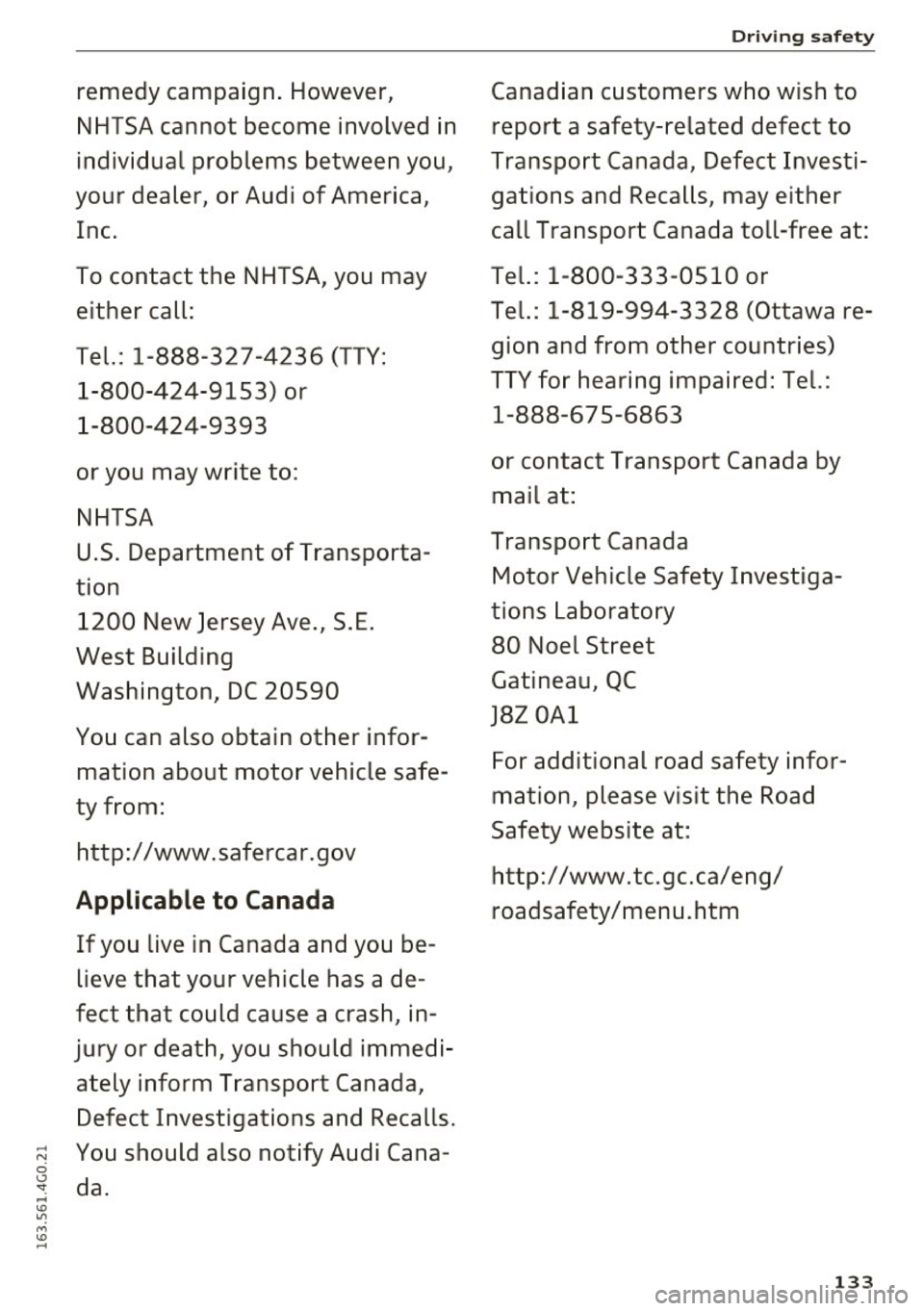
remedy campaign. However,
NHTSA cannot become involved in
individual problems between you,
your dealer, or Audi of America ,
Inc.
To contact the NHTSA , you may
either call:
Tel.: 1-888-327-4236 (TTY: 1 -800-424-9153) or
1-800-424-9393
or you may wr ite to :
NHTSA
U .S. Department of Transporta
tion 1 200 New Jersey Ave., S.E .
West Building
Washington, DC 20590
You can also obtain other infor
mation about motor vehicle safe
ty from:
http:/ /www.safercar.gov
Applicable to Canada
I f you live in Canada and you be
lieve that your vehicle has a de
fect that could cause a crash, in
jury or death, you should immedi
ately inform Transport Canada ,
Defect Investigations and Recalls.
;::: You should also notify Audi Cana
o
~ da . ...
'° V,
"' '° ...
Driving safety
Canadian customers who wish to
report a safety-related defect to
Transport Canada , Defect Investi
ga tions and Recalls , may either
call Transport Canada toll -free at :
Tel.: 1 -800 -333-0510 or
T el. : 1-819-994-3328 (Ottawa re
gion and from other countries)
TTY for hearing impaired: Tel. :
1-888-675-6863
or contact Transport Canada by mai l at :
T ranspo rt Canada
Motor Vehicle Safety Investiga
tions Laboratory
80 Noel Street
Gatineau , QC
J8 Z 0Al
For addit ional road safety infor
mation, please vis it the Road
Safety website at :
http:/ /www.tc.gc.ca/eng/
roadsafety/menu.htm
1 33
Page 136 of 294
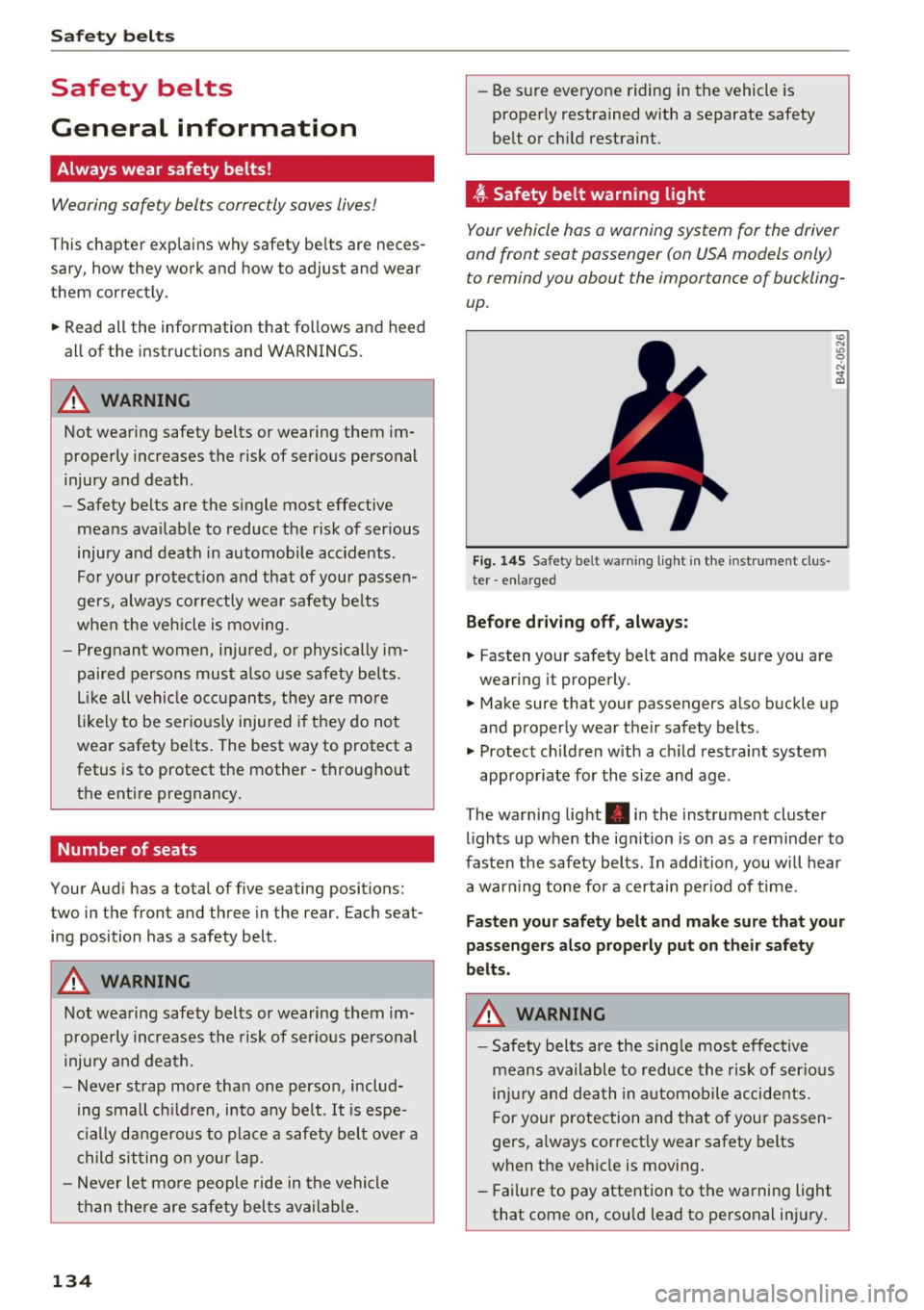
Safety belt s
Safety belts
General information
Always wear safety belts!
Wearing safe ty belts correctly saves lives!
This chapte r explains why safety be lts a re neces
sary, how they work and how to adjust and wear
them correct ly.
.. Read all the information that follows and heed
all of the instructions and WARNINGS.
&_ WARNING
Not wea ring safety belts or wearing them im
properly increases the risk of ser ious personal
injury and dea th .
- Safety belts are the s ingle most effective
mea ns ava ilab le to reduce the risk of serious
injury and dea th in automob ile accidents .
For yo ur protect ion and that of your passe n
gers, alw ays co rre ctly wea r sa fety be lt s
when the veh icle is moving .
- Pregnant wom en, in ju re d, o r physically i m
paired persons mus t also use s afety be lts.
L ik e all vehi cle o ccu pants, they are mo re
li kely to be serio usly injure d if th ey do no t
wea r safety be lts. The best way to protect a
fetus is to protect the mothe r -th roughout
the ent ire pregnancy .
Number of seats
Your Audi has a total of five seating positions:
two in the front and three in the rear. Each seat
i n g position has a safety belt.
&_ WARNING
N ot wea ring safety bel ts or weari ng them im
properly increases th e r isk of ser ious personal
inju ry and dea th.
- N ever st rap more tha n one perso n, includ
ing small ch ildren, into a ny be lt .
It is espe
ci ally dan gerous to pla ce a sa fety bel t over a
c hild s itting on you r lap.
- N ever le t mo re people ride in t he vehicle
t h an t he re are saf ety bel ts availab le.
134
-Be sure everyone riding in the vehicle is
properly restrained with a separate safety
be lt or ch ild restraint.
~ Safety belt warning light
Your vehicle has a warning system for the driver
and front seat passenger (on USA models only)
to remind you about the importance of buckling
up .
Fig. 14S Safety be lt wa rning lig ht in the inst rument clu s
ter -en larged
Before driving off, alway s:
.. Fasten your sa fety belt and make sure you are
wearing it prope rly .
(0
"'
"' 9
"'
and proper ly wea r th eir safety belts .
.. Protec t ch ild ren w ith a c hild restraint system
app ropr iate for the size and age .
The wa rning lig ht . in the inst rument cluste r
li ghts up w hen the ig nition is o n as a rem inder to
fasten the safety belts. In addition , you w ill hear
a war ning tone for a cert ain period of time.
Fasten your safety belt and make sure that your
passengers also properly put on their safety
belts.
&_ WARNING
-
- Safety belts are the sing le most effective
means av ailable to re duc e the ris k of ser ious
in jur y and de ath in a utomo bile acciden ts.
F or your protection and that o f yo ur p assen
ge rs, a lways cor rect ly wear safety belts
when t he vehicle is moving .
- Fa ilure to pay atte ntion to the wa rning light
that come on, cou ld lead to personal in jury.
Page 137 of 294
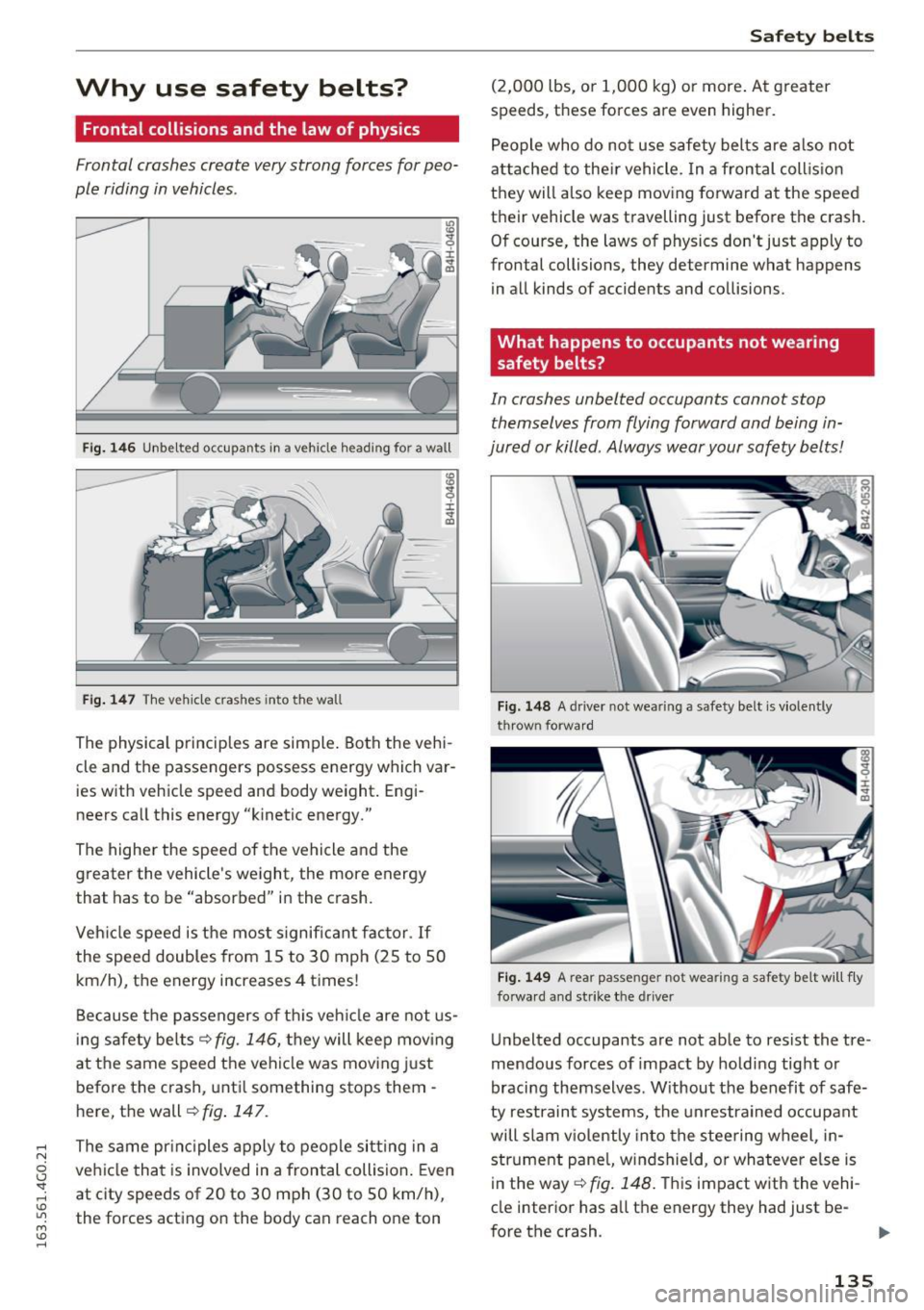
.... N
0 CJ '
Why use safety belts?
Frontal collisions and the law of physics
Frontal crashes create very strong forces for peo
ple riding in vehicles .
Fig. 146 Unbelted occupants in a vehicle heading for a wall
Fig . 147 The vehicle crashes into the wall
CD
~ ±
cle and the passengers possess energy which var
ies with vehicle speed and body weight. Engi
neers call this energy "kinetic energy."
The higher the speed of the vehicle and the
greater the vehicle's weight, the more energy
that has to be "absorbed" in the crash.
Veh icle speed is the most significant factor.
If
the speed doubles from 15 to 30 mph (25 to SO
km/h), the energy increases 4 times!
Because the passengers of this vehicle are not us
ing safety belts ¢
fig. 146, they will keep mov ing
at the same speed the vehicle was moving just
before the crash, until something stops them -
here, the wall ¢
fig. 147.
The same principles apply to people sitting in a
vehicle that is involved in a frontal collision. Even
at city speeds of 20 to 30 mph (30 to SO km/h),
the forces acting on the body can reach one ton
Safety belts
(2,000 lbs, or 1,000 kg) or more . At greater
speeds, these forces are even higher.
People who do not use safety belts are also not
attached to their vehicle. In a frontal collision
they will also keep moving forward at the speed
their vehicle was travelling just before the crash.
Of course, the laws of physics don't just apply to
frontal collisions, they determine what happens in all kinds of accidents and collisions.
What happens to occupants not wearing
safety belts?
In crashes unbelted occupants cannot stop
themselves from flying forward and being in
jured or killed . Always wear your safety belts!
Fig. 148 A dr iver not wea ring a safe ty belt is v io lent ly
throw n forward
Fig. 149 A rea r passe nge r not wea ring a safe ty belt will f ly
forwa rd and strike th e
driver
Unbelted occupants are not able to resist the tre
mendous forces of impact by holding tight or
bracing themselves . Without the benefit of safe
ty restraint systems, the unrestrained occupant
will slam viol ently into the steering wheel, in
strument panel, windshield , o r whatever else is
in the way
¢fig. 148. This impact with the vehi
cle interior has all the energy they had just be-
fore the crash . ..,.
135
Page 138 of 294
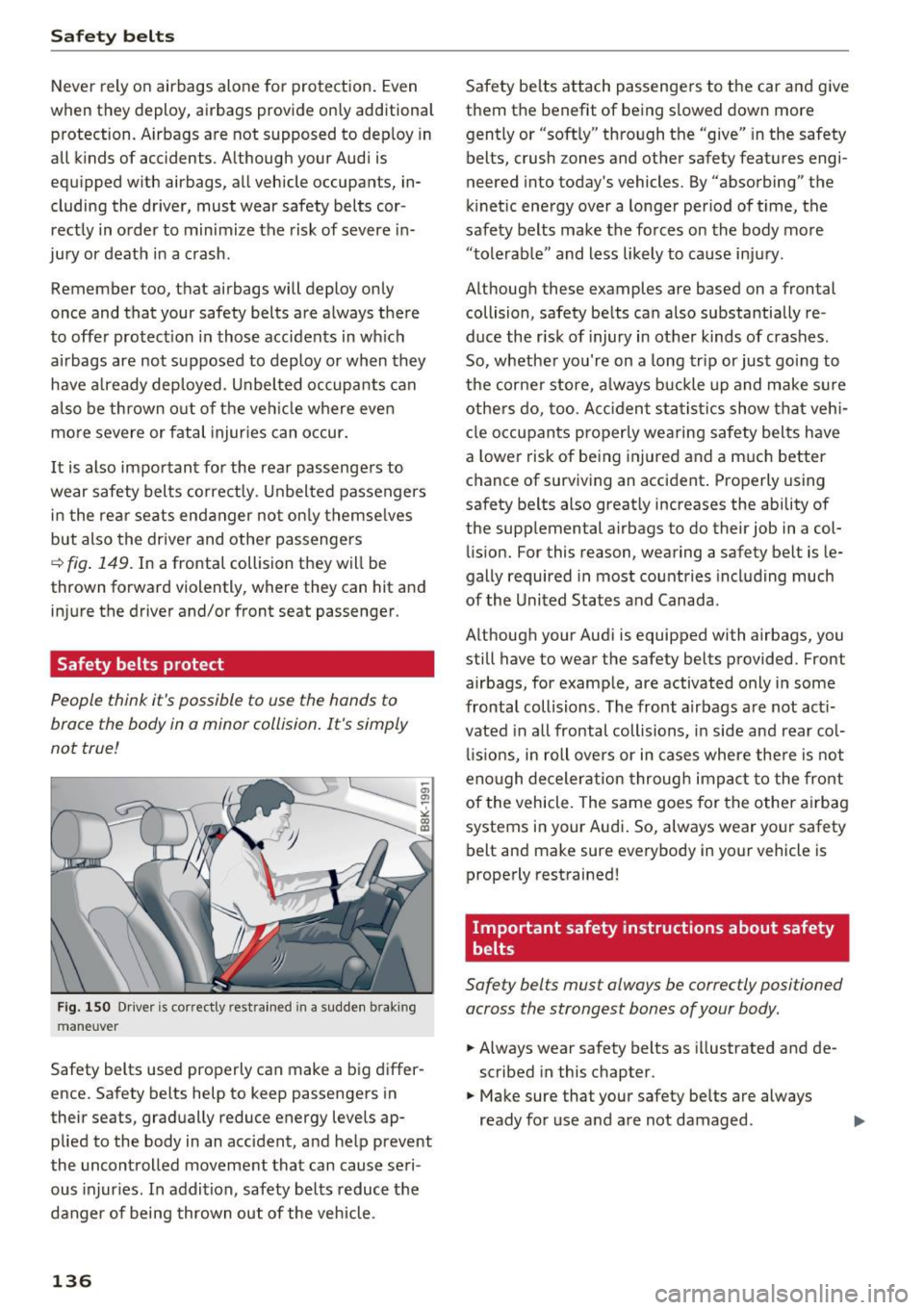
Safe ty belts
Never rely o n airbags alone for protection . Even
when they deploy, airbags provide only additional
protection. A irbags are not supposed to dep loy in
all kinds of accidents. A lthough your Audi is
equipped w ith airbags, all vehicle occupants, in
cluding the driver, must wear safety belts cor
rectly in order to minimize the risk of severe in
jury or death in a crash .
Remember too, that airbags will deploy only
once and that your safety belts are a lways there
to offer protect ion in those accidents in wh ic h
airbags are not supposed to deploy or when they
have a lready dep loyed. Unbel ted occupants can
a lso be thrown o ut of the veh icle where eve n
mo re severe or fatal injur ies can occur .
It is also important for the rear pass enge rs to
wear safety belts co rrectly. Unbelted passengers
i n t he rea r seats endanger no t on ly themse lves
but also the drive r and other passengers
~ fig . 149. In a frontal collision they will be
thrown forward violently, where they can hit and
in jure the driver and/or front seat passenger.
Safety belts protect
People think it's possible to use the hands to
brace the body in a minor collision . It's simply
not true!
F ig . 1 50 Driver is correctly restrai ned in a sudde n braking
m aneuver
Safety belts used properly can make a b ig d iffer
ence. Safety belts help to keep passengers in
their seats, gradually reduce energy levels ap
plied to the body in an accident, and he lp prevent
the uncont rolled moveme nt that can cause seri
ous injur ies. In addition, safety belts reduce the
danger of being thrown out of the veh icle .
136
Safety be lts attach passengers to the car an d give
them the benefit of being s lowed down more
gently or "soft ly" thro ugh the "give" in the safety
belts, crush zones and other safety feat ures engi
neered into today's vehicles. By "absorbing" the
k inet ic energy over a longer per iod of t ime, the
safety belts make the forces on the body more
"tole rab le" and less likely to cause inj ury.
Although these examples are based on a frontal
collision, safety be lts ca n also substantially re
duce the r isk o f injury in ot her kinds of crashes.
So, whethe r yo u're on a long trip or just going to
the cor ne r store, a lways b uckle up and make s ure
othe rs do, too. Ac ciden t stat ist ics show that veh i
cl e o ccupants prope rly wearing safety bel ts have
a lowe r risk of being injured and a m uch better
chance of surviving an acc ident . Properly using
safety be lts also great ly increases the ability of
the supp lemental airbags to do their job in a col
li sion. For this reason, wearing a safety belt is le
gally required in most countries including much
of the United States and Canada .
Although your Aud i is equipped with airbags, you
still have to wear the safety belts provided. Front
airbags, for examp le, are activated only in some
frontal collisions. The front airbags are not act i
vated in all frontal collisions, in side and rear co l
li sions, in roll overs or in cases where the re is not
eno ugh deceleration throug h impa ct to the front
of the vehicle. The same goes for the other a irbag
systems in your Audi. So, always wear your safety
belt and make sure everybody in your vehicle is
properly rest rained!
Important safety instructions about safety
belts
Safety belts must always be correctly positioned
across the strongest bones of your body.
.,. Always wear safety belts as illustrated and de
scribed in this chapter.
.,. Make sure that your safety be lts are always
ready fo r use a nd are not damaged .
Page 139 of 294
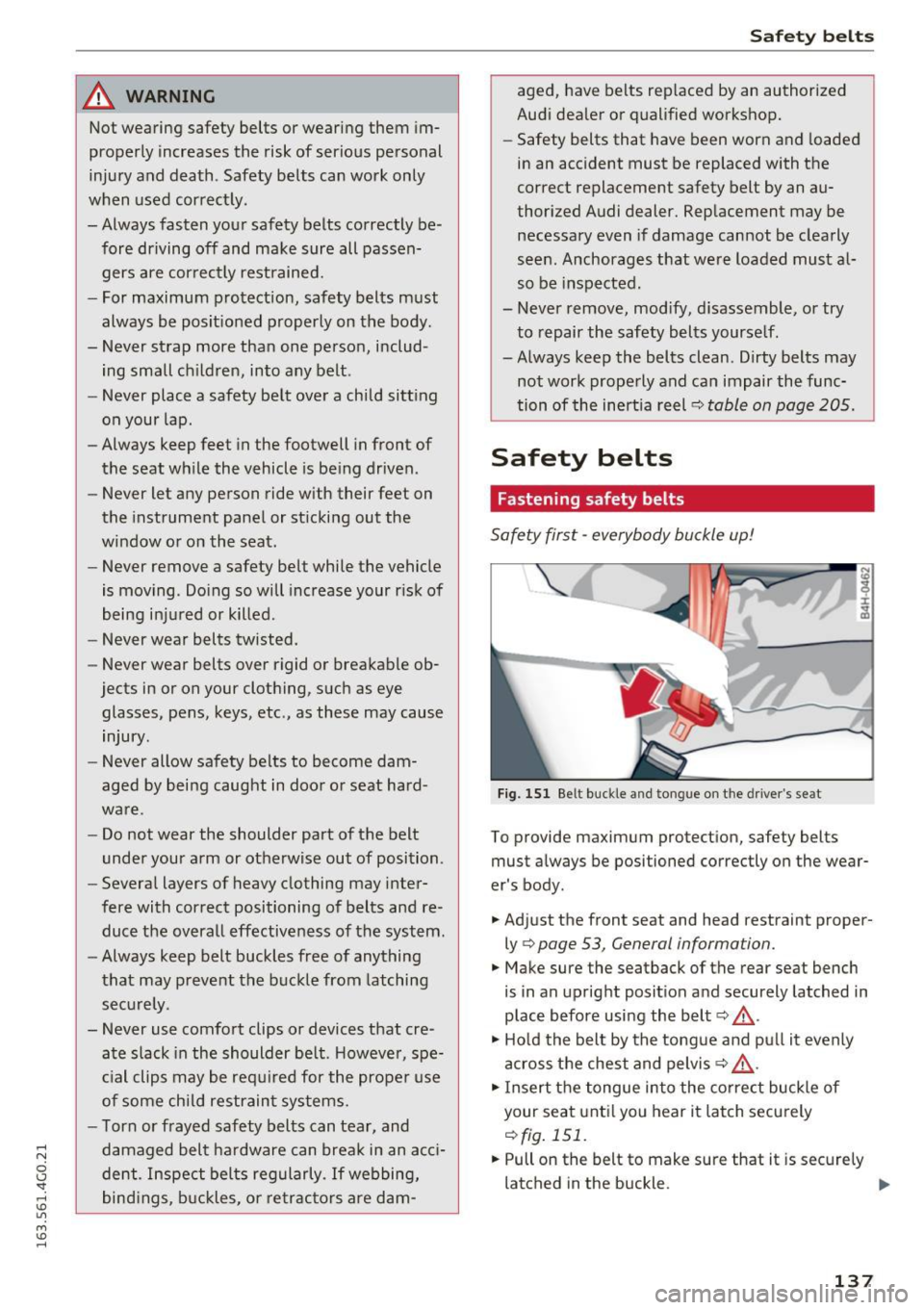
.... N
0 CJ '
_& WARNING
Not wearing safety belts or wearing them im
properly increases the risk of serious personal
injury and death . Safety belts can work only
when used correct ly.
-Always fasten your safety belts correctly be fore driving off and make sure all passen
gers are cor rect ly restrained.
- For maximum protection, safety belts must
always be posit ioned properly on the body .
- Never strap more than one person, includ
ing small ch ildren, into any belt .
- Never place a safety belt over a child sitt ing
on your lap.
- Always keep feet in the footwell in front of
the seat wh ile the vehicle is being driven.
- Never let any person ride w ith their feet on
the instrument panel or sticking out the
window or on the seat .
- Never remove a safety belt while the vehicle
is moving . Do ing so will increase your risk of
being injured or k illed.
- Never wear belts twisted.
- Never wear belts over rigid or breakable ob-
jects in or on your clothing, such as eye
glasses, pens, keys, etc., as these may cause
injury.
- Never allow safety belts to become dam
aged by being caught in door or seat hard
ware.
- Do not wear the shoulder part of the belt
under your arm or otherwise out of position .
- Several layers of heavy clothing may inter
fere with correct positioning of belts and re
duce the overall effectiveness of the system.
- Always keep belt buckles free of anything
that may prevent the buckle from latching
securely .
- Never use comfort clips or devices that cre
ate slack in the shoulder be lt . However, spe
cial clips may be requ ired for the proper use
of some child restraint systems.
- Torn or frayed safety belts can tear, and
damaged belt ha rdware can break in an acc i
dent. Inspect belts regularly .
If webbing,
bind ings, buckles, or re tractors are dam-
Safet y bel ts
aged, have belts rep laced by an authorized
Aud i dea ler or qualified workshop.
- Safety belts that have been worn and loaded
in an accident must be replaced with the
correct replacement safety belt by an au
thor ized Audi dealer. Replacement may be
necessary even if damage cannot be clearly
seen. Anchorages that were loaded must al
so be inspected.
- Never remove, mod ify, d isassemble, or try
to repair the safety belts yourse lf.
-Always keep the belts clean . Dirty belts may
not work properly and can impair the func
tion of the inert ia reel¢
table on page 205.
Safety belts
Fastening safety belts
Safety first -everybody buckle up!
Fig. 151 Belt buckle and tongu e on t he d river' s se at
To provide maximum protection, safety belts
must always be positioned correctly on the wear
er 's body .
... Adjust the front seat and head restraint proper
ly ¢
page 53 , General information.
... Make sure the seatback of the rear seat bench
is in an upright posit ion and securely latched in
place before using the belt
Q _&. .
"' Ho ld the bel t by the tongue and pu ll it evenly
across the chest and pelvis¢_&. .
... Insert the tongue into the correct buckle of
your seat unti l you hear it latch securely
Qfig. 151.
... Pull on the belt to make sure that it is securely
latched in the buckle.
Iii>
137
Page 140 of 294
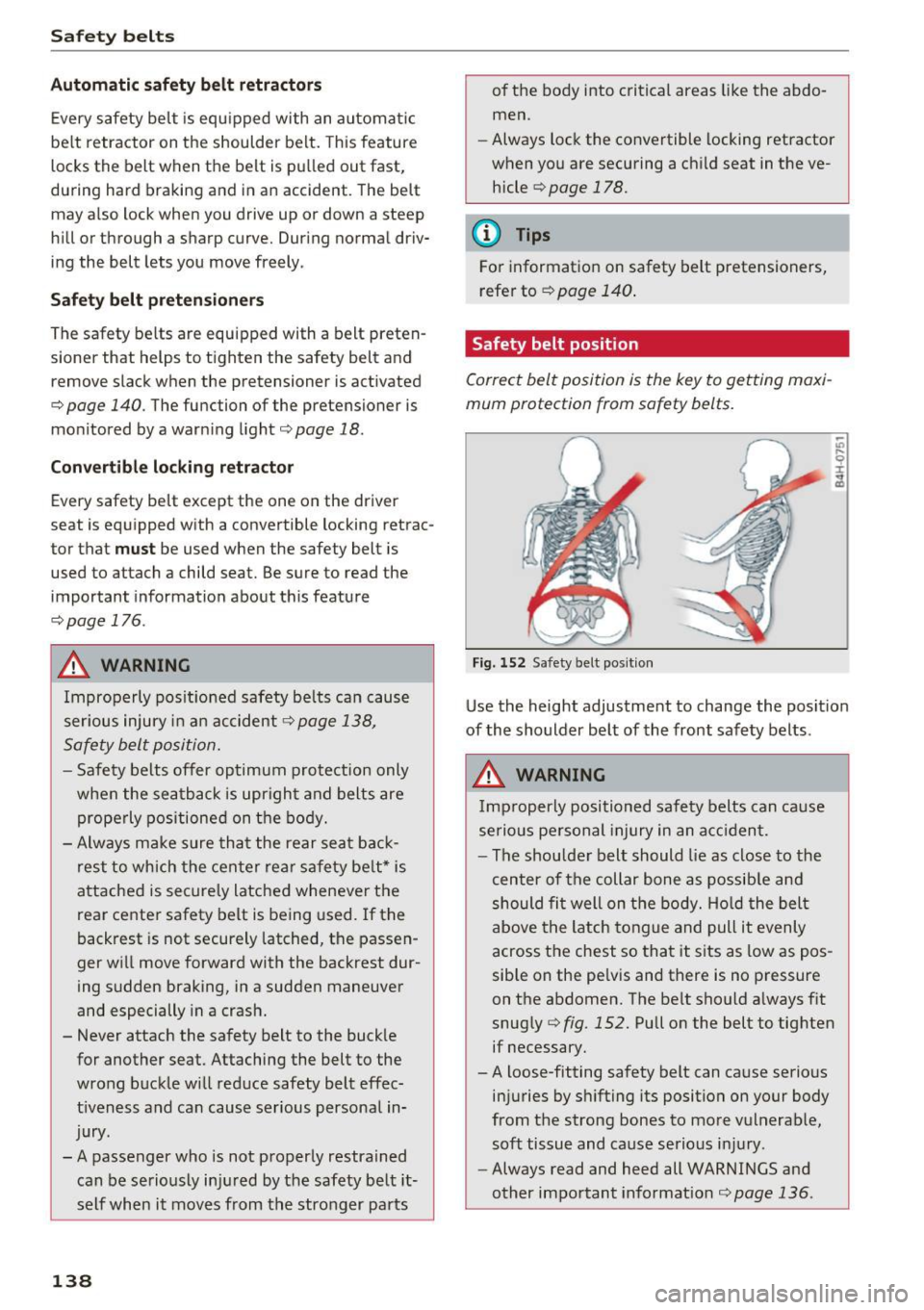
Safe ty belts
Autom ati c s afet y belt retr actors
Every safety belt is equ ipped with an automa tic
be lt retractor on the shoulder belt. This feature
locks the belt when the belt is pulled out fast,
during hard braking and in a n accident . The belt
may a lso lock when you drive up or down a steep
hill or through a sharp curve. Dur ing normal driv
ing the belt lets you
move freely .
Safety belt p ret en sion ers
The safety belts are equipped with a belt preten
sioner that helps to t ighten the safety belt and
remove slack when the pretensioner is activated
¢
page 140 . The function of the pretensioner is
mon itored by a warn ing light
¢page 18.
Con vertible loc king retracto r
Every safety belt except the one on the driver
seat is equipped with a convertible locking retrac
tor that
must be used when the safety belt is
used to attach a child seat. Be sure to read the
important information about this feature
¢ page 176 .
.&_ WARNING
Improperly pos it ioned safety be lts can cause
ser ious injury in an accident ¢
page 138,
Safety belt position.
- Safety belts offer optimum protection only
when the seatback is upright and belts are
properly positioned on the body.
- Always make sure that the rear seat bac k
rest to which the center rea r safety belt* is
attached is secure ly latched whenever the
rear center safety belt is being used. If the
backrest is not securely latched, the passen
ger will move forward with the backrest dur
ing sudden braking, in a sudden maneuver
and especially in a crash.
- Never attach the safety belt to the buckle for another seat. Attaching the belt to the
wrong b uckle will reduce safety belt effec
t iveness and can cause serious persona l in
jury.
- A passenger who is not properly restrained can be seriously in jured by the safety be lt it
self when it
moves from the stronger parts
138
of the body into critical areas like the abdo men.
- Always lock the convertible locking retractor
when you are securing a child seat in the ve
hicle
¢ page 178.
(D Tips
For information on safety belt pretensioners,
refer to¢
page 140 .
Safety belt position
Correct belt position is the key to getting maxi
mum protection from safety belts.
Fig. 152 Safety belt posit ion
Use the height adjustment to change the posit ion
of the shoulder belt of the front safety belts .
.&_ WARNING
Imp roperly positioned safety belts can cause
serio us pe rsonal injury in an a cc ident.
- The shou lde r belt should lie as close to the
center of the collar bone as possib le and
should fi t well on the body. Ho ld the belt
above the latch to ngue and pull it evenly
across the chest so that it sits as low as pos
sible on the pe lvis and there is no pressure
on the abdomen. The belt should a lways f it
snug ly ¢
fig. 152. Pull on the belt to tighten
if necessary.
- A loose-fitting safety belt can cause serious
injuries by sh ifting its position on your body
from the strong bones to more vulnerable,
soft tissue and cause serious i nju ry .
- Always read and heed all WARNINGS and
other important informat ion
r=;, page 136 .